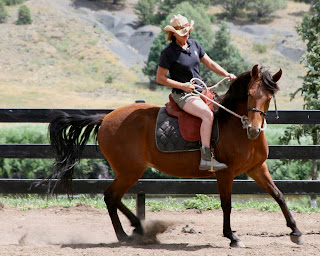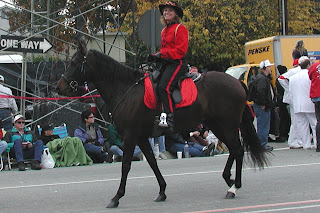The Mangalarga Marchador has a natural marching gait. However, there are times when you need to "set or train" gait. One is when they are young and need to learn how to balance a rider and stay at a steady pace. The other is when you have screwed it up. This is a story of the latter.
 |
| Seamus da Boa Fe, imported in-utero, grandson of Malibu da Santa Terezinha. |
 |
| He loves to be picked! |
Seamus is a great Mangalarga Marchador – proud, good size and like all Marchador horses, very sweet. He was a family member almost his whole life. We kept him a stallion – our first – and he taught us quite a bit about horsemanship along the way. He was the first horse we ever started under saddle and he did just fine at that. But we also made a number of mistakes with Seamus.
 |
| Young Seamus |
The first in my mind is that we didn’t freeze his semen! But the one that refers to this topic is that Seamus learned to piaffe and passage before he learned to walk (march). It was very impressive to see a gaited horse doing dressage. In the ring, he looked like a Lusitano or Andalusian. We probably could have faked it and entered their competitions, since in the early 2000s there were no Marchador show classes.
He passed his ABCCMM inspection, but the Brasilians were telling us what to do to straighten out his marcha.
 |
| Seamus doing Spanish Walk at the Fiesta of the Spanish Horse |
The dressage training had asked for him to elevate which he could do very well. During the time when his muscles should have been asking for extension to get long and cover ground, he was being asked to collect and prance. Elegant he was; smooth, he was not.
To make matters worse, while in a training barn, his feet were not trimmed right. In shoes they looked okay to us, but when he threw a shoe, we saw what we had and were horrified. His toes were so long! He was lame without shoes. We consulted 3 farriers and each recommended a significantly different approach. Seamus is the reason we took the initiative and studied barefoot trimming ourselves.
This summer, we have turned the corner. Seamus is sound, and I have started riding him again. Now starting over, I still do dressage moves, but I also practice the marcha, as our great friend Tresa Smith, (Montana Marchadors) would like. Because it is important to have the MM breed march.
The words of the Brasilians ringing in my ears from so many years ago, I started to find his march and keep him in it. Here is my approach:
§ Long straight distances asking Seamus to cover ground in the march.
§ Speed for batida. Almost a canter, but right at the moment that he will transition, I say no, this is the speed.
§ Uphill work.
§ “ALLOW” the gait to happen. When he is gaiting along, I leave him alone and let him know this feels good and is right.
|
Lynn and Seamus this summer in Pagosa. |
For Seamus, right before the canter, his legs are going like a little duck, very quick, almost disjointed, but guess what? It is very good! We have always used Koyote as our measure for a great marcha batida. Seamus looks to be about the same! Right now, he is the best in uphills and very fast, but as we practice keeping the rhythm, the smooth marcha gait comes out more and more often. It’s really just building muscle memory and of course, the muscles and stamina we need to maintain it.
 |
| He's very athletic and talented! |
For a slow gait, Seamus can do a walk that is close to marcha picada. I keep him slow because I can hear the rhythm and get it right. Right now, he can only do this moving slowly, but I think in time, we can increase the speed and have him stay in it. It’s very smooth, so I use it, especially going down hills. Of course, with his previous training, he can still elevate. Whenever he gets nervous, he passages!
We are so excited! Seamus is an exhilarating and fun horse to ride. He loves to work and loves the attention. We hope he will stay sound and just impress the heck out of anyone who sees him move!
Practice riding in the marching gait.
Young horses will often speed up and slow down. You need to teach them to be consistent and to set the speed where their gait is most comfortable. Lazy or smart horses may pick a movement that is easier for them or that they enjoy more like a canter or going sideways.
Or as in our story, your discipline may ask for another gait. If so, spend as much time marching as you do cantering or piaffing!
 |
| Koyote Libertas, ridden by Felipe Ribeiro, our marcha batida standard. |
Summerwind is trying to bring up some Brasilian trainers to help owners and breeders learn how to set or improve the marcha gait. No dates have been set. Because we ride bitless, we are sending them a Dr. Cook bitless bridle to practice that. Most Brasilians will use bits. We will keep you posted on our progress.







